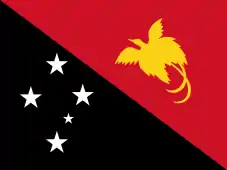Agriculture in Papua New Guinea
Agriculture in Papua New Guinea has a more than 7,000 years old history. Currently around 85% of Papua New Guinea's population lives from semi-subsistence agriculture.[1]
Papua New Guinea produces and exports agricultural, timber, and fish products. Agriculture in 2017 accounted for 22.1% of the GDP[2] and supported more than 80% of the population. Cash crops ranked by value are coffee, oil, cocoa, copra, tea, rubber, and sugar. The timber industry was not active in 1998, due to low world prices, but rebounded in 1999. About 40% of the country is covered with timber rich trees, and a domestic woodworking industry has been slow to develop. Fish exports are confined primarily to shrimp, although fishing boats of other nations catch tuna in Papua New Guinea waters under license.
History
People in Papua New Guinea started practising agriculture around 7,000 – 10,000 years ago. The oldest evidence for this is in the Kuk Swamp area, where planting, digging and staking of plants, and possibly drainage have been used to cultivate taro, banana, sago and yam.[5]
Between the 17th to 19th centuries, a small number of plant species, including sweet potato, cassava and tobacco have been brought from the Americas by Europeans and introduced to Indonesia from where they spread to New Guinea. In the second part of the 19th century and especially after 1870 further crops have been introduced directly by Europeans, including beans, pumpkin, corn, watermelon, papaya, mangosteen, durian, orange, lemon, coffee, lime and guava.[5]
Production
Papua New Guinea produced in 2018:
- 2.4 million tons of palm oil (9th largest world producer);
- 1.3 million tons of banana;
- 1.2 million tons of coconut (7th largest world producer);
- 1.1 million tons of fruits, fresh nes;
- 728 thousand tons of sweet potato (17th largest world producer);
- 375 thousand tons of yam;
- 356 thousand tons of root and tubers;
- 325 thousand tons of vegetable;
- 271 thousand tons of taro;
- 241 thousand tons of maize (green);
- 237 thousand tons of sugar cane;
- 152 thousand tons of cassava;
- 107 thousand tons of berries nes;
- 57 thousand tons of coffee;
- 44 thousand tons of cocoa;
In addition to smaller productions of other agricultural products, like natural rubber (7.7 thousand tons) and tea (5.5 thousand tons). [6]
Major agricultural products
Sweet potato
Sweet potato is a major food in PNG and dominates production in the highlands.[7] It is one of PNGs top five staple foods taking the top position 99%, followed by banana with 96% and taro with 95%.[8]
Coffee
Coffee production in Papua New Guinea accounts for a little over 1% of the total world production according to the United Nations Conference on Trade and Development (UNCTAD).[9] After oil palm, coffee is Papua New Guinea's second largest agricultural export, employing approximately 2.5 million people.
Copra
Copra has been cultivated in New Guinea since the late 19th century, originally by German colonialists. Production has continued by Australian interests since World War II.
See also
References
| Wikimedia Commons has media related to Agriculture in Papua New Guinea. |
- AusAID: About Papua New Guinea Archived 2011-05-18 at the Wayback Machine, retrieved 5 May 2011
- "East Asia/Southeast Asia: Papua New Guinea". The World Factbook - Central Intelligence Agency. Retrieved 2019-09-21.
- "Papua New Guinea Economy Papua New Guinean Economy, business opportunities in Papua New Guinea government Papua New Guinea business opportunities import and export opportunities". www.globaltenders.com. Retrieved 2020-08-15.
- admin (2018-10-31). "Papua New Guinea Economic Report". Prime Advisory Network. Retrieved 2020-08-15.
- Bourke, R. Michael (2009). "History of agriculture in Papua New Guinea" (PDF). In Bourke, R. Michael; Harwood, Tracy (eds.). Food and Agriculture in Papua New Guinea. Canberra: ANU E Press. doi:10.22459/fapng.08.2009. ISBN 978-1-921536-60-1.
- Papua New Guinea production in 2018, by FAO
- Bourke, R. Michael; Gibson, John; Quartermain, Alan; Barclay, Kate; Allen, Bryant; Kennedy, Jean (2009). "Food Production, Consumption and Imports" (PDF). In Bourke, R. Michael; Harwood, Tracy (eds.). Food and Agriculture in Papua New Guinea. Canberra: ANU E Press. doi:10.22459/fapng.08.2009. ISBN 978-1-921536-60-1.
- Bourke, R. Michael; Harwood, Tracy, eds. (2009). Food and Agriculture in Papua New Guinea. Canberra: ANU E Press. doi:10.22459/fapng.08.2009. ISBN 978-1-921536-60-1.
- "Coffee Industry Corporation Limited" (PDF). United Nations Conference on Trade and Development (UNCTAD). Archived from the original (PDF) on 24 August 2009. Retrieved 24 September 2010.
